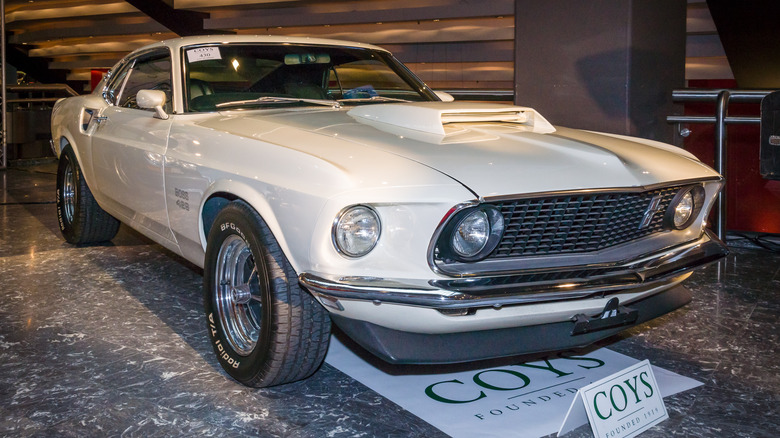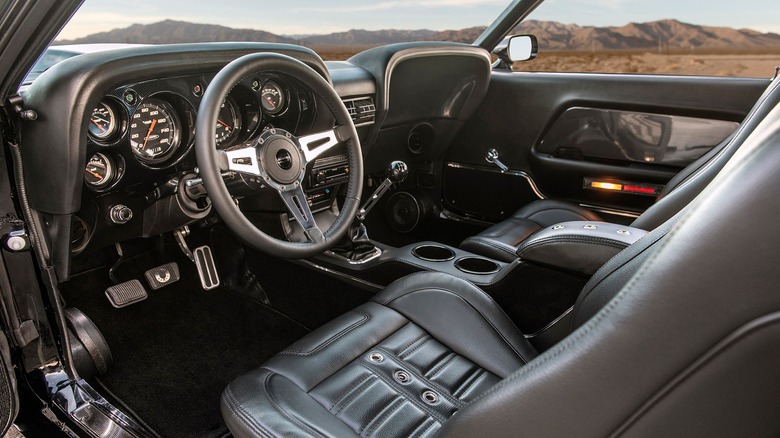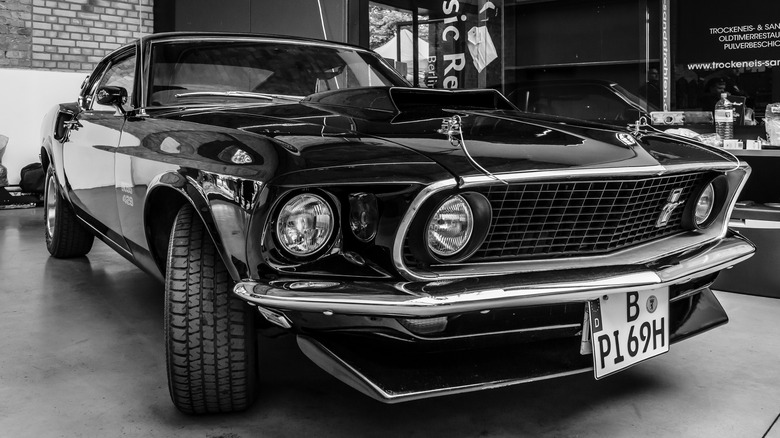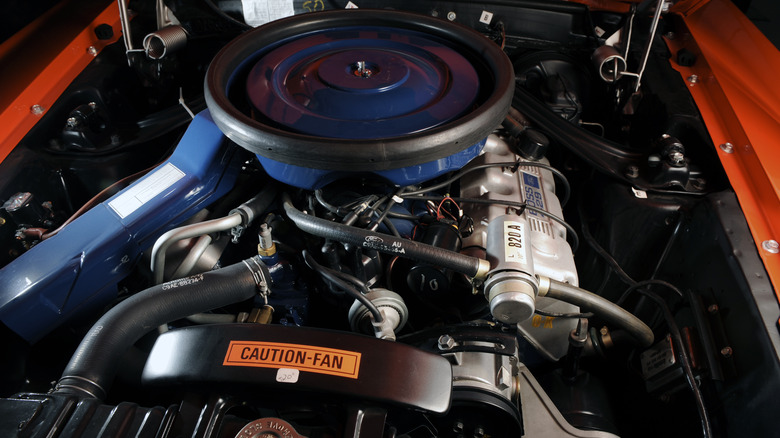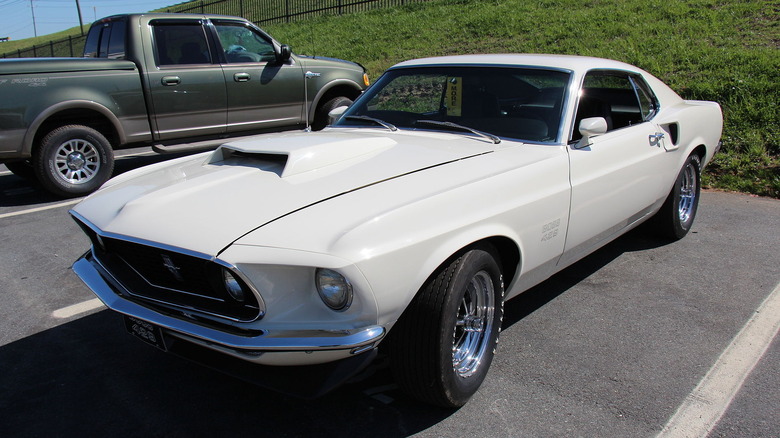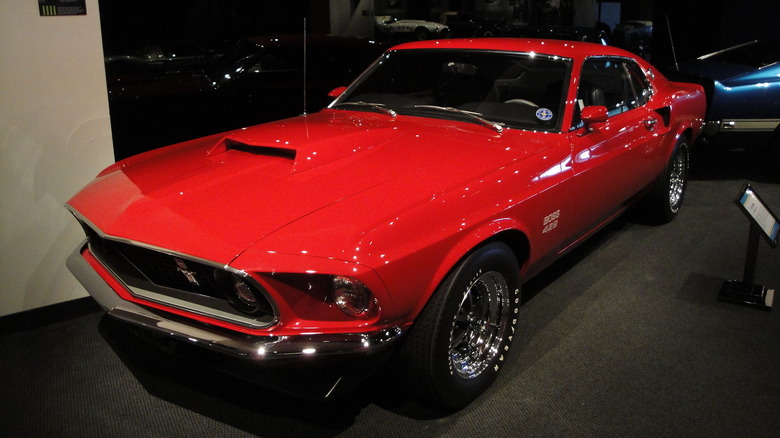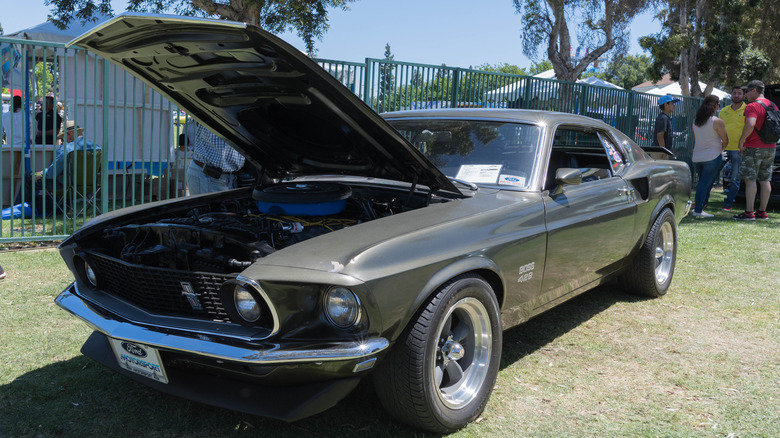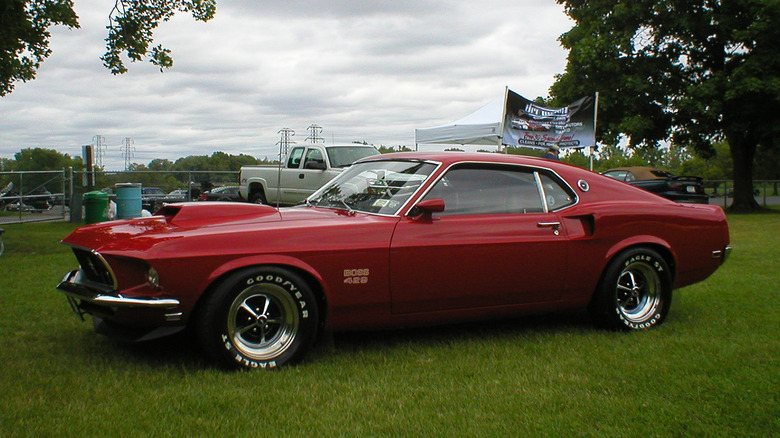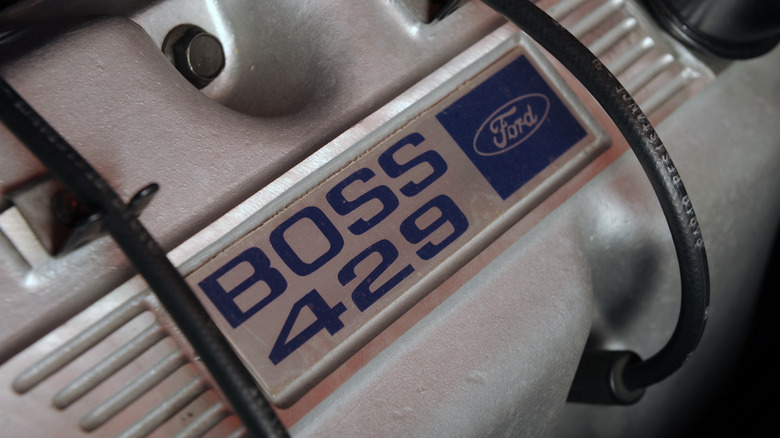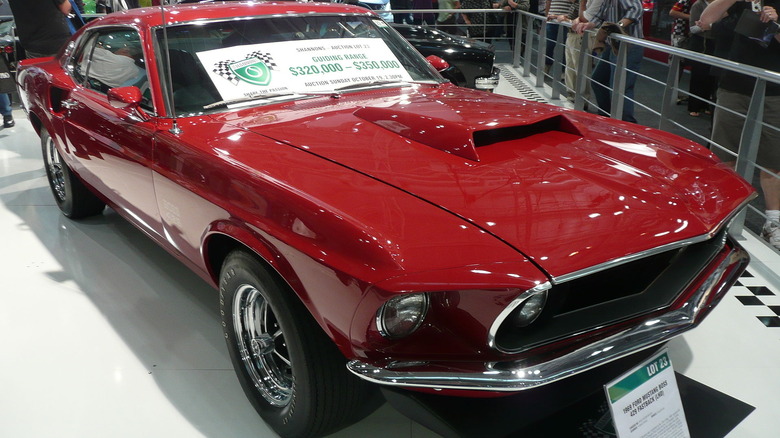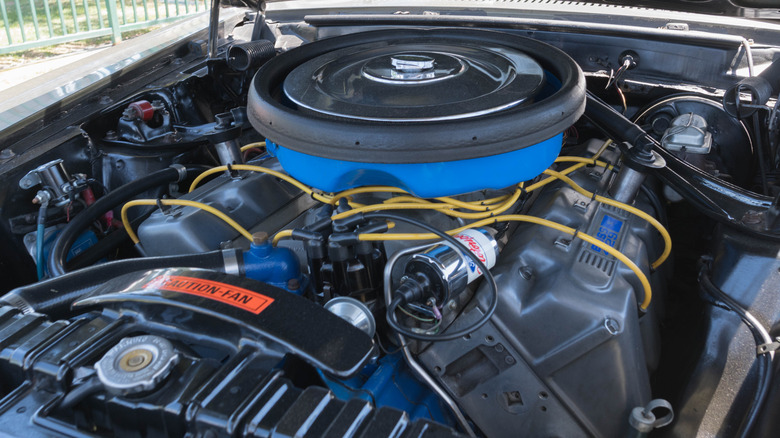10 Interesting Facts About The 1969 Ford Mustang Boss 429
With more than a half-century of production, the Ford Mustang is an institution of American highways. Lauded for its sharp styling, lightweight construction, and excellent handling, it has been a best-selling American sports car throughout its run. While American car companies have scaled back their offering of cars in favor of crossovers and SUVs, the Mustang stands strong and appears to be a part of the American auto industry over the next half-century.
The last two decades of Mustang have spawned many special editions with modifications from the factory as well as aftermarket tuners, such as Saleen and Roush. But there was a heyday for special edition Mustangs before in the late '60s, providing us with great cars such as the Shelby GT350, Cobra Jet, and Mach 1. Great as those cars may be, the 1969-1970 Boss 429 is the baddest and most powerful among them all. With a giant V8 in the relatively small Mustang chassis, the Boss 429 is a tire-shredding tour de force. Although it may not be as well known as others, it is a cool car to have a closer look at. To that end, here are 10 interesting facts about the 1969 Ford Mustang Boss 429.
The engine was too large
Mustangs from the start had been fitted with Ford's general-purpose inline 6-cylinder engine found in cars across the range, with V8 engines optional. At first, Ford offered the 289 and later the 302 and 351. All of these engines bolted in directly from the factory with no problems and were installed on a large number of Mustangs. When Ford wanted to take the Mustang to the track, it needed more power, and the best way to get more power is more displacement. Therefore, a 429 cu. in. engine was meant to be shoehorned into the car to give it the power needed to win. But it did not fit.
Kar Kraft was a custom car fabricator and race car builder in the '60s but had only one client, Ford. It was responsible for building the legendary GT40 and, when the time came to make the Boss 429, Kar Kraft's help was enlisted. Due to the massive size of the engine, according to Riga Master Workshop, the shock towers had to be cut and moved to make way for the engine and exhaust manifolds. The battery was moved to the trunk and a smaller brake booster had to be fitted. Every dimension of the engine was oversized and had to be compensated for, and the extra weight necessitated a ¾ in. sway bar to be installed on the rear to help make up for the weight up front.
Built for NASCAR
In the '60s, Ford was heavily involved in racing. The infamous rivalry between Henry Ford and Enzo Ferrari should be clear evidence of Ford's willingness to compete on the track. At the time, Chrysler's 426 HEMI engine was dominating the race track and Ford wanted to even the field with a new car. While a Ford Torino would have been a logical choice, the Mustang was Ford's dedicated sports car and would likely perform better due to its lower weight.
The 429 engine is part of the Ford Lima engine family, of which the 370, 429, and 460 belong — Ford also made a 514 and 572, but only as crate engines for racing. Most of these large displacement engines went into medium-duty trucks and, in stock form, would be inadequate for a race car. The Boss 429 had specially built heads with what's called a "twisted hemi" design, per Street Muscle Magazine. The engine also featured an oversquare design in which the stroke was shorter than the bore, which gives it the ability to rev higher. Redline for the 429 was set at 6,000 RPM, an impressive figure for a large engine and ideal for heading through the straights of a track at full speed.
It only lasted two years
Ford offered many special edition cars in the late '60s. It brought in a variety of designers and program managers to create cars for different purposes. Some were meant to build special cars that could be bought and raced on the weekends by amateurs, while the Boss 429 was developed for factory-sponsored racing. Since the cars had to be built by specialty shops, such as Kar Kraft, the time and effort to make the cars rose significantly as well as the price.
The original retail price, per Supercars.net, was $4,087, which was nearly double the base price of a Mustang in 1969. The total production for the first year was 859 units with the following year seeing only 500 more, the minimum required by NASCAR homologation rules. With so few built, they are rare and valuable. People who own them likely prefer not to drive them as it can result in devaluation, but there is a slightly more affordable option. Classic Restorations builds brand-new Boss Mustangs from original Ford blueprints, fully licensed by the factory for a cost under $200,000. While that may be a lot of money, it is still significantly less than a Boss 429 at auction and comes with guilt-free driving.
The engine has no head gaskets
[Featured image by Sicnag via Wikimedia Commons | Cropped and scaled | CC BY 2.0]
A lot of things set the Boss 429 apart from every other Mustang. The engine development is no different. While the block was based on existing designs used in other applications, the heads were unique. It uses hemispherical combustion chambers and the heads are sealed to the engine with no gaskets.
Instead of using a typical head gasket, the Boss engine has a groove around the top of each cylinder in which a Cooper ring, an all-metallic sealing ring, is fitted. Oil and water passages were sealed with o-rings. This system has been used in other racing applications and delivers superior sealing performance, allowing the engine to withstand enormous pressure and create as much power as possible, per Mac's Motor City. This did create some issues for owners in that most Ford dealerships did not have technicians trained to service such high-performance engines, leaving owners without any recourse for a broken car, a sad situation for someone who paid nearly double for the privilege of owning a Boss Mustang.
It was the brainchild of Larry Shinoda
[Featured image by Greg Gjerdingen via Wikimedia Commons | Cropped and scaled | CC BY 2.0]
Larry Shinoda was a consequential figure in the automotive industry, particularly in the '50s and '60s. Although he had been interned as a Japanese-American during WWII, he was born in Southern California, and that is the area that has given us some of the best hotrods and custom cars ever built.
After getting booted from art school in California, Shinoda ended up in Detroit where he, like so many other Detroiters, worked in the automaking business, per Hagerty. He managed to work with legends Dick Teague and John DeLorean before joining General Motors. There, his hands touched upon the final designs of the Corvette, Corvair, and multiple prototypes including the CERV I and CERV II. He joined Ford after his tenure ended at GM in 1969. He had been a young hotrodder in California and used that passion to help Ford create cars to compete with the then-new Z/28 Camaro, and the Boss 302 and Boss 429 Mustangs are what resulted from his work. However, Ford manager Bunkie Knudsen, a long-time friend of Shinoda, was fired in 1969 and Shinoda left with him. He would continue to work as a consulting designer until he died of cancer in the '90s. His stint with Ford was brief, but it left us with one of the best Mustangs ever built.
Current values are high
The Boss 429 Mustang sold for about $4,000 when new and that was nearly double the base price for a Mustang, as noted above. This meant that not as many people could buy them, but it did not matter since it was a homologation special and not many would be made anyway. With only 1,359 units produced, they were rare when new, and being one of very few Mustangs with a big block V8 makes it desirable even today.
The market for classic cars has gone especially crazy in recent years, with many records being set for European and American classics alike. That said, the Boss 429 is not among the highest valued, but it still goes for more than the price of most houses. Motorious reported about a blue 429 that sold in June 2022 with a closing bid of $442,000. Bonhams listed another one before the price curve shot upward with a final value of $346,000 in October 2020. Finally, Hagerty reported on a nice green 429 that went for $357,500 at Mecum Dallas in 2021. While some sell for less, anyone who finds one in a barn is sure to have a ready-made payday coming soon.
It received many checkered flags
[Featured image by CJ DUB via Wikimedia Commons | Cropped and scaled | CC BY 2.0]
Ford dumped a bunch of money into racing throughout the '60s and much of it paid off. The Boss 429 was no exception. With a purpose-built giant engine built to racing specifications dropped into a lightweight chassis, the ingredients for a winning car were all there. Engine performance is delivered thanks to its large size and unique heads as well as 2.23 in. intake valves with 1.71 in. exhaust valves, forged rods and pistons, forged cross-drilled steel crank, four-bolt main caps, and 1.5:1 compression. All of these beefy components were fed by a high-flow 735 cfm Holley four-barrel carburetor (via Which Car).
These components made for a car that would go very fast, although, with such a heavy engine, cornering would not be its strong suit. Still, oval track racing uses wide bends and cornering is not as important as straight-line speed. The Boss 429 in 1969 won more than half of the 54 races it entered, with 11 wins coming back to back, according to Heacock classic. Unfortunately, Ford pulled nearly all sponsorship for factory-backed racing starting in 1970 and the Boss 429 saw little action after that. From there, it was left to private teams to run their own cars.
Code named Job 1
Cars under development are often, if not always, given a code name before being completed and ready for production. The first car rolling out of production from a special development is a big deal to those involved. It is an accomplishment to those putting it together, and, especially when it took a lot of work to make everything fit, there's a great sense of satisfaction with that first one off the line.
The first Boss 429 Mustang was called Job 1. Since this was a low-volume, high-performance car, most of them are still around. Job 1 is also still around, and Motor Trend tracked down its history, finding out that it spent most of its life not far from where it was made. Its second owner set it up for drag racing and it spent many nights tearing down the quarter-mile, but the trail went cold after 1985.
Ford is and always has been a marketing behemoth. Its ad campaigns have a long reach and penetrate American culture. And, like all car companies, it uses slogans to sell the public an image. In 1981, that slogan was "Quality is Job 1." Apparently, this can refer to many cars that are first to come off the line, but it would be nice to think that it is, indeed, referring to the Boss 429 Mustang of 1969.
It was the most powerful Mustang of its time
[Featured image by CJ DUB via Wikimedia Commons | Cropped and scaled | CC BY 2.0]
Mustangs and cars in general of late have grown exponentially in power ratings, to an almost absurd degree. Every manufacturer keeps upping one another with huge horsepower ratings, with the top-performing models reaching 500, 600, and even 700 horsepower. Only technology seems to be capping it. However, this horsepower war is nothing new. The late '60s, often seen as the golden age of the muscle car, was another time of increasingly high horsepower cars.
Back then, the technology was nowhere near as efficient as today, so the only way to increase power was to increase the size of the engines. This is true for the Chrysler 426 HEMI, the Chevrolet 396 or 427, and also Ford's venerable 429. In the Boss Mustang, the rated power output, according to Mustang Specs, was officially 375 horsepower, although many at the time suspected it was actually higher. Until the modern era, this was the most powerful Mustang built, with the Mustang GT Cobra Jet being the next most powerful at 335 horsepower.
It came in unique colors
One of the things that fans appreciate about cars made in times past is the array of colors available. Many vibrant hues that once adorned cars are not seen as much anymore. It seems so many cars today are silver, black, white, or muted shades of red or blue — and the rich and colorful displays formerly popular on cars are now a rarity.
The Boss 429 was offered with completely different color options each year, however, all of the interiors were black only, per Motor Trend. 1969 saw the car covered in Raven Black, Wimbledon White, Royal Maroon, Candy Apple Red, and Black Jade. 1970 saw the cars with Grabber Orange, Grabber Green, Grabber Blue, Calypso Coral, and Pastel Blue, providing a more vibrant selection of colors for the second year. That these limited production cars used different colors for the two years of production makes the existing cars that much more unique and special, and shall contribute to the likely future elevation of value.
